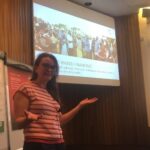Workshop Summary: Hydrological Services for Business
contributed by Shaun Harrigan, ECMWF
Over 60 participants ranging from consultancy companies, hydro-meteorological services, (re)insurance, and academia were welcomed at the European Centre for Medium-Range Weather Forecasts (ECMWF) in Reading, UK from the 8th to 9th of May 2018 to meet with the Global Flood Awareness System (GloFAS) development team. They were provided the opportunity to shape the future of GloFAS forecasting products and service provision. GloFAS is part of the Copernicus Emergency Management Service.

Participants at the ‘Hydrological Services for Business’ workshop at ECMWF in Reading 8th to 9th May 2018; Photo by ECMWF
The first session introduced GloFAS and the need for a global hydrological service. Peter Salamon from the European Commission Joint Research Centre (JRC) kicked off proceedings giving an overview of the Copernicus Emergency Management Service in providing hazard information for improved disaster management in Europe. David Green from NASA put forward the case that hydrological services are critical for global businesses by reducing risk and building resilience. Sazzard Hossain, Marcio Moraes, and Anshul Agarwal presented case study applications of GloFAS for flood forecasting in Bangladesh, Brazil, and Myanmar, respectively.
- David Green from NASA. Photos by Hannah Cloke.
- Catalina Jaime from the Red Cross Red Crescent Climate Centre. Photos by Hannah Cloke.
In the second session Catalina Jamie from the Red Cross Red Crescent Climate Centre showed the importance of hydrological services in the humanitarian sector for providing forecast-based financing allowing action before a disaster happens. John Bevington from JBA Consulting demonstrated that innovative products can be produced by combining raw GloFAS output with flood hazard maps via their Flood Foresight service.

Participants defining what makes a good global hydrological service and discussing the barriers of service uptake. Photo by ECMWF.
Plenty of lively discussion at the poster session. Photo by Hannah Cloke.
Participants got a chance to provide input during an interactive session on defining the most important criteria for a good global hydrological service. Common feedback included provision of information in regions lacking data and scientific capacity in order to aid local decision making; information on quality of forecasts (skill, accuracy, reliability) and associated documentation; service reliability; and availability of training material. Identified key barriers of service uptake included a perceived/actual lack of skill in the service in the region of interest; lack of access to discharge observations in many parts of the globe to allow model calibration and forecast evaluation; and managing the volume and complexity of forecast data.
The interactive participation continued with 3 minute ‘ignite’ talks ranging from Jan Verkade on the Deltares GLOSSIS system for storm surge forecasting, Matteo DallAmico on ‘mysnowmaps.com’, to Andy Wood highlighting hydrological prediction developments at NCAR. There were lively discussions and networking at the evening poster session.
Plenty of lively discussion at the poster session. Photo by Hannah Cloke.

Christel Prudhomme from ECMWF kicking off the interactive session on shaping the future of GloFAS. Photo by Hannah Cloke.
Day 2 turned towards how users can help shape future products and service provision of GloFAS. Arthur Essenfelder from the Euro-Mediterranean Centre on Climate Change (CMCC) talked on the importance of co-development between service providers and end users using climate services as an example. This provided fodder for the second interactive session where participants provided their input on improving current products (i.e. 30-day flood and seasonal forecasts) and shaping the development of future products (i.e. weekly forecast summary and rapid flood risk assessment).
The final session concentrated on how to improve service provision to end users. Carlo Buontempo from ECMWF showed how large complex datasets are made easily accessible to a variety of end users within the Copernicus Climate Change Service (C3S) Climate Data Store (CDS) together with an online interactive toolbox for retrieving, analysing and plotting data (will go live later in June). Jim Nelson from Brigham Young University (BYU) showed how tailor-made GloFAS forecasts at smaller spatial scales can be provided to the community and presented the infrastructure that enables a service to deliver local access to global forecast data. The session finished by asking users to describe their workflows in regards to obtaining forecast information through ‘user stories’. This feedback will be used to prioritise future GloFAS service developments with the aim to better accommodate user needs.
Peter Salamon closed the workshop and thanked the speakers and participants for their enthusiastic participation and valuable feedback during the interactive sessions that will help prioritise developments and shape the future of GloFAS. Workshop presentations are available online here.
An optional GloFAS training session took place after the workshop which included many hands-on exercises for participants to discover the different products and how they could be used for decision-making.

GloFAS training given by Ruth Coughlan, ECMWF. Photo by Louise Arnal.
About GloFAS
GloFAS went fully operational as a 24/7 supported service on the 23rd of April 2018. GloFAS is part of the Copernicus Emergency Management Service and provides forecasts of floods up to 30 days ahead as well as outlooks of high and low flows up to 4 month ahead in rivers across the world. GloFAS has currently over 1,600 registered users. Its forecasts are freely available to all users and can be accessed here.




0 comments